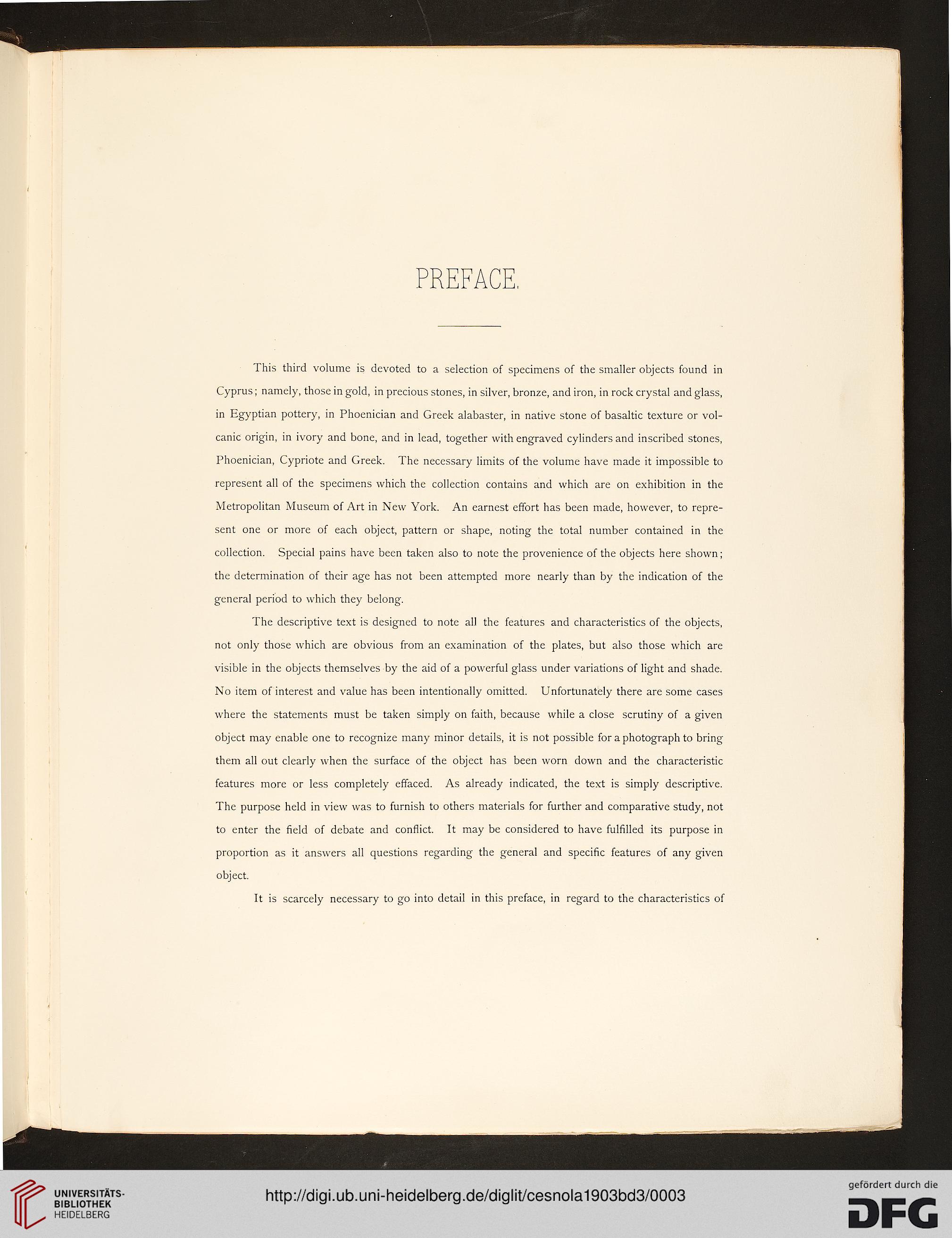PREFACE.
This third volume is devoted to a selection of specimens of the smaller objects found in
Cyprus; namely, those in gold, in precious stones, in silver, bronze, and iron, in rock crystal and glass,
in Egyptian pottery, in Phoenician and Greek alabaster, in native stone of basaltic texture or vol-
canic origin, in ivory and bone, and in lead, together with engraved cylinders and inscribed stones,
Phoenician, Cypriote and Greek. The necessary limits of the volume have made it impossible to
represent all of the specimens which the collection contains and which are on exhibition in the
Metropolitan Museum of Art in New York. An earnest effort has been made, however, to repre-
sent one or more of each object, pattern or shape, noting the total number contained in the
collection. Special pains have been taken also to note the provenience of the objects here shown;
the determination of their age has not been attempted more nearly than by the indication of the
general period to which they belong.
The descriptive text is designed to note all the features and characteristics of the objects,
not only those which are obvious from an examination of the plates, but also those which are
visible in the objects themselves by the aid of a powerful glass under variations of light and shade.
No item of interest and value has been intentionally omitted. Unfortunately there are some cases
where the statements must be taken simply on faith, because while a close scrutiny of a given
object may enable one to recognize many minor details, it is not possible for a photograph to bring
them all out clearly when the surface of the object has been worn down and the characteristic
features more or less completely effaced. As already indicated, the text is simply descriptive.
The purpose held in view was to furnish to others materials for further and comparative study, not
to enter the field of debate and conflict. It may be considered to have fulfilled its purpose in
proportion as it answers all questions regarding the general and specific features of any given
object.
It is scarcely necessary to go into detail in this preface, in regard to the characteristics of
This third volume is devoted to a selection of specimens of the smaller objects found in
Cyprus; namely, those in gold, in precious stones, in silver, bronze, and iron, in rock crystal and glass,
in Egyptian pottery, in Phoenician and Greek alabaster, in native stone of basaltic texture or vol-
canic origin, in ivory and bone, and in lead, together with engraved cylinders and inscribed stones,
Phoenician, Cypriote and Greek. The necessary limits of the volume have made it impossible to
represent all of the specimens which the collection contains and which are on exhibition in the
Metropolitan Museum of Art in New York. An earnest effort has been made, however, to repre-
sent one or more of each object, pattern or shape, noting the total number contained in the
collection. Special pains have been taken also to note the provenience of the objects here shown;
the determination of their age has not been attempted more nearly than by the indication of the
general period to which they belong.
The descriptive text is designed to note all the features and characteristics of the objects,
not only those which are obvious from an examination of the plates, but also those which are
visible in the objects themselves by the aid of a powerful glass under variations of light and shade.
No item of interest and value has been intentionally omitted. Unfortunately there are some cases
where the statements must be taken simply on faith, because while a close scrutiny of a given
object may enable one to recognize many minor details, it is not possible for a photograph to bring
them all out clearly when the surface of the object has been worn down and the characteristic
features more or less completely effaced. As already indicated, the text is simply descriptive.
The purpose held in view was to furnish to others materials for further and comparative study, not
to enter the field of debate and conflict. It may be considered to have fulfilled its purpose in
proportion as it answers all questions regarding the general and specific features of any given
object.
It is scarcely necessary to go into detail in this preface, in regard to the characteristics of




